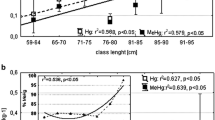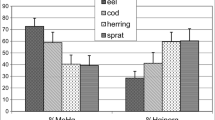Abstract
Total and methylmercury concentrations were determined in muscle and organ tissue from a wide variety of marine and terrestrial organisms spanning several trophic levels. Sediment and water samples from many of the tissue sampling sites were also analyzed to assess the degree of mercury contamination to which the animals were exposed. The methylmercury to total mercury ratios were examined to determine whether this ratio is indicative of elevated exposure to organic or inorganic mercury and how it varies relative to tissue type and position in the food chain. As an ancillary study, a subset of these tissues was analyzed as 1) wet tissue, and 2) freeze-dried, ball-milled tissue to determine whether the form of sample preparation can adversely affect mercury analysis. Results indicate that the methylmercury to total mercury ratios generally approach unity only in muscle tissue of higher food chain carnivorous fish residing in waters that are relatively uncontaminated with respect to inorganic mercury species. Herbivorous terrestrial mammals and low food chain marine organisms tend to have very low methylmercury to total mercury ratios. Marine animals placed higher on the food chain, such as crabs and lobsters, exhibit somewhat higher methylmercury to total mercury ratios and can exhibit a large variation in this ratio between, organ tissue and muscle tissue of the same animal. The samples analyzed as both wet and freeze-dried, ball-milled tissue indicate that freezedrying and ball-milling in no way result in mercury loss or contamination and, in fact, result in better replicate analyses and create a sample sufficiently stable to be archived for several years without refrigeration.
Similar content being viewed by others
References
Bloom, N.: 1989,Can. J. Fish. Aq. Sci. 46, 1131–1140.
Huckabee, J. W.; Goldstein, R. A., Janzen, S. A. and Woock, S. E.: 1975, Proc. Int. Conf. Heavy Metals in the Environment. Toronto, Canada. 199–215.
Konovolov, Y. D.: 1994,Hydrobiol. J. 30, 47
Siegel, B. Z., Siegel, S. M., Correa, T., Dagan, C., Galvez, G., LeeLoy, L., Padua, A., and Yeager, E.: 1991,Arch. Environ. Contam. Toxicol. 20, 241–246.
U. S. Geological Survey (USGS): 1991, Circular 1072.
Wright, D. A., Welbourn, P. M., and Martin, A. V. M.: 1991,Wat., Air, Soil Pollut. 56, 697–707.
Author information
Authors and Affiliations
Rights and permissions
About this article
Cite this article
Lasorsa, B., Allen-Gil, S. The methylmercury to total mercury ratio in selected marine, freshwater, and terrestrial organisms. Water Air Soil Pollut 80, 905–913 (1995). https://doi.org/10.1007/BF01189743
Issue Date:
DOI: https://doi.org/10.1007/BF01189743




